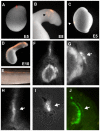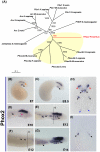Expression of sympathetic nervous system genes in Lamprey suggests their recruitment for specification of a new vertebrate feature
- PMID: 22046306
- PMCID: PMC3203141
- DOI: 10.1371/journal.pone.0026543
Expression of sympathetic nervous system genes in Lamprey suggests their recruitment for specification of a new vertebrate feature
Abstract
The sea lamprey is a basal, jawless vertebrate that possesses many neural crest derivatives, but lacks jaws and sympathetic ganglia. This raises the possibility that the factors involved in sympathetic neuron differentiation were either a gnathostome innovation or already present in lamprey, but serving different purposes. To distinguish between these possibilities, we isolated lamprey homologues of transcription factors associated with peripheral ganglion formation and examined their deployment in lamprey embryos. We further performed DiI labeling of the neural tube combined with neuronal markers to test if neural crest-derived cells migrate to and differentiate in sites colonized by sympathetic ganglia in jawed vertebrates. Consistent with previous anatomical data in adults, our results in lamprey embryos reveal that neural crest cells fail to migrate ventrally to form sympathetic ganglia, though they do form dorsal root ganglia adjacent to the neural tube. Interestingly, however, paralogs of the battery of transcription factors that mediate sympathetic neuron differentiation (dHand, Ascl1 and Phox2b) are present in the lamprey genome and expressed in various sites in the embryo, but fail to overlap in any ganglionic structures. This raises the intriguing possibility that they may have been recruited during gnathostome evolution to a new function in a neural crest derivative.
Conflict of interest statement
Figures




Similar articles
-
Neural crest origin of sympathetic neurons at the dawn of vertebrates.Nature. 2024 May;629(8010):121-126. doi: 10.1038/s41586-024-07297-0. Epub 2024 Apr 17. Nature. 2024. PMID: 38632395 Free PMC article.
-
Functional constraints on SoxE proteins in neural crest development: The importance of differential expression for evolution of protein activity.Dev Biol. 2016 Oct 1;418(1):166-178. doi: 10.1016/j.ydbio.2016.07.022. Epub 2016 Aug 5. Dev Biol. 2016. PMID: 27502435
-
The lamprey: a jawless vertebrate model system for examining origin of the neural crest and other vertebrate traits.Differentiation. 2014 Jan-Feb;87(1-2):44-51. doi: 10.1016/j.diff.2014.02.001. Epub 2014 Feb 20. Differentiation. 2014. PMID: 24560767 Free PMC article.
-
Specification of sensory neuron cell fate from the neural crest.Adv Exp Med Biol. 2006;589:170-80. doi: 10.1007/978-0-387-46954-6_10. Adv Exp Med Biol. 2006. PMID: 17076281 Review.
-
Evolutionary and Developmental Associations of Neural Crest and Placodes in the Vertebrate Head: Insights From Jawless Vertebrates.Front Physiol. 2020 Aug 13;11:986. doi: 10.3389/fphys.2020.00986. eCollection 2020. Front Physiol. 2020. PMID: 32903576 Free PMC article. Review.
Cited by
-
Hagfish to Illuminate the Developmental and Evolutionary Origins of the Vertebrate Retina.Front Cell Dev Biol. 2022 Jan 26;10:822358. doi: 10.3389/fcell.2022.822358. eCollection 2022. Front Cell Dev Biol. 2022. PMID: 35155434 Free PMC article. Review.
-
Acquisition of neural crest promoted thyroid evolution from chordate endostyle.Sci Adv. 2025 Aug 8;11(32):eadv2657. doi: 10.1126/sciadv.adv2657. Epub 2025 Aug 6. Sci Adv. 2025. PMID: 40768591 Free PMC article.
-
Evolution of the hypoxia-sensitive cells involved in amniote respiratory reflexes.Elife. 2017 Apr 7;6:e21231. doi: 10.7554/eLife.21231. Elife. 2017. PMID: 28387645 Free PMC article.
-
A Phox2b BAC Transgenic Rat Line Useful for Understanding Respiratory Rhythm Generator Neural Circuitry.PLoS One. 2015 Jul 6;10(7):e0132475. doi: 10.1371/journal.pone.0132475. eCollection 2015. PLoS One. 2015. PMID: 26147470 Free PMC article.
-
Evolution and Development of the Inner Ear Efferent System: Transforming a Motor Neuron Population to Connect to the Most Unusual Motor Protein via Ancient Nicotinic Receptors.Front Cell Neurosci. 2017 Apr 24;11:114. doi: 10.3389/fncel.2017.00114. eCollection 2017. Front Cell Neurosci. 2017. PMID: 28484373 Free PMC article. Review.
References
-
- Gess RW, Coates MI, Rubidge BS. A lamprey from the Devonian period of South Africa. Nature. 2006;443:981–984. - PubMed
-
- Janvier P. Palaeontology: modern look for ancient lamprey. Nature. 2006;443:921–924. - PubMed
-
- Kuraku S, Hoshiyama D, Katoh K, Suga H, Miyata T. Monophyly of lampreys and hagfishes supported by nuclear DNA-coded genes. Journal of molecular evolution. 1999;49:729–735. - PubMed
-
- Osorio J, Retaux S. The lamprey in evolutionary studies. Development Genes and Evolution. 2008;218:221–235. - PubMed
-
- Le Douarin N. Cambridge University Press; 1982. The neural crest.
Publication types
MeSH terms
Substances
Grants and funding
LinkOut - more resources
Full Text Sources

